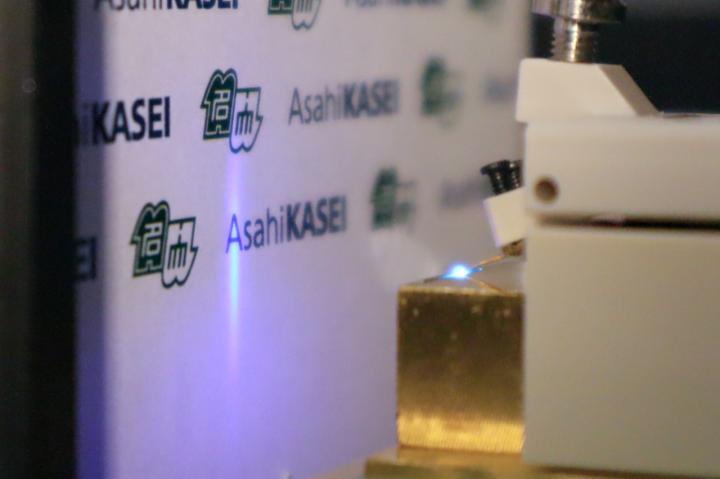

Far field pattern of UV-C laser projected onto a fluorescent screen.
Credit: 2019 Asahi Kasei Corp. and Nagoya University
“Our laser diode emits the world's shortest lasing wavelength, at 271.8 nanometers (nm), under pulsed [electric] current injection at room temperature,” says Professor Chiaki Sasaoka of Nagoya University's Center for Integrated Research of Future Electronics.
Previous efforts in the development of ultraviolet laser diodes had only managed to achieve emissions down to 336 nm, Sasaoka explains.
Laser diodes that emit short-wavelength ultraviolet light, which is called UV-C and is in the wavelength region of 200 to 280 nm, could be used for disinfection in healthcare, for treating skin conditions such as psoriasis, and for analysing gases and DNA.
The Nagoya University deep-ultraviolet laser diode overcomes several issues encountered by scientists in their work towards the development of these semiconducting devices.
The team used a high quality aluminium nitride (AlN) substrate as their base for building up the layers of the laser diode. This, they say, is necessary, since lower quality AlN contains a large amount of defects, which ultimately impact the efficiency of a laser diode's active layer in converting electrical into light energy.
In laser diodes, a 'p-type' and 'n-type' layer are separated by a 'quantum well'. When an electric current is passed through a laser diode, positively charged holes in the p-type layer and negatively charged electrons in the n-type layer flow towards the center to combine, releasing energy in the form of light particles called photons.
The researchers designed the quantum well so that it would emit deep UV light. The p- and n-type layers were made from aluminium gallium nitride (AlGaN). Cladding layers, also made from AlGaN, were placed on either side of the p- and n-type layers. The cladding below the n-type layer included silicon impurities, a process called doping. Doping is used as a technique to modify a material's properties.
The cladding above the p-type layer underwent distributed polarization doping, which dopes the layer without adding impurities. The aluminium content in the p-side cladding was designed so that it was highest at the bottom, decreasing towards the top. The researchers believe this aluminium gradient enhances the flow of positively charged holes. A top contact layer was finally added that was made from p-type AlGaN doped with magnesium.
The researchers found that the polarization doping of the p-side cladding layer meant that a pulsed electric current of “remarkably low operating voltage” of 13.8V was needed for the emission of “the shortest wavelength reported so far.”
The team is now conducting advanced joint research with Asahi Kasei Corporation to achieve continuous room temperature deep-UV lasing for the development of UV-C semiconductor laser products.
###
The article, “A 271.8 nm deep-ultraviolet laser diode for room temperature operation,” was published online in Applied Physics Express on October 30, 2019, at DOI: 10.7567/1882-0786/ab50e0.
For more information, contact:
Prof. Chiaki Sasaoka
Center for Integrated Research of Future Electronics, Institute of Materials Research and System for Sustainability, Nagoya University
Email: sasaoka@nagoya-u.jp
About Nagoya University
Nagoya University has a history of about 150 years, with its roots in a temporary medical school and hospital established in 1871, and was formally instituted as the last Imperial University of Japan in 1939. Although modest in size compared to the largest universities in Japan, Nagoya University has been pursuing excellence since its founding. Six of the 18 Japanese Nobel Prize-winners since 2000 did all or part of their Nobel Prize-winning work at Nagoya University: four in Physics – Toshihide Maskawa and Makoto Kobayashi in 2008, and Isamu Akasaki and Hiroshi Amano in 2014; and two in Chemistry – Ryoji Noyori in 2001 and Osamu Shimomura in 2008. In mathematics, Shigefumi Mori did his Fields Medal-winning work at the University. A number of other important discoveries have also been made at the University, including the Okazaki DNA Fragments by Reiji and Tsuneko Okazaki in the 1960s; and depletion forces by Sho Asakura and Fumio Oosawa in 1954.












